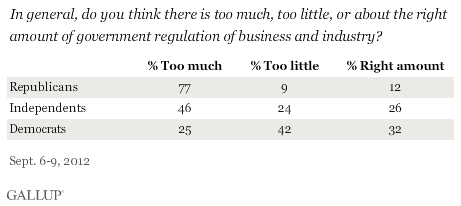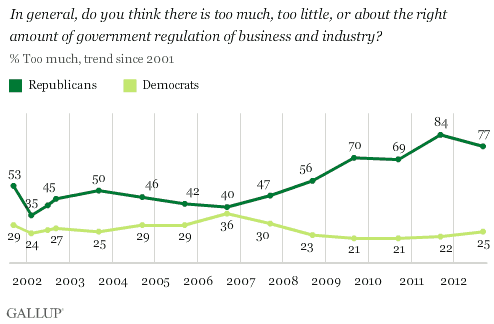PRINCETON, NJ -- Americans say there is too much (47%) rather than too little (26%) government regulation of business and industry, with 24% saying the amount of regulation is about right. Americans have been most likely to say there is too much regulation of business over the last several years, but prior to 2006, Americans' views on the issue of government regulation of business were more mixed.

The collapse of Lehman Bros., the failure of the secondary mortgage market, and other business problems in 2008 and 2009 might have been expected to increase Americans' desire for more government control of business and industry. But that was not the case. Americans' views that there is too much government regulation in fact began to rise in 2009, perhaps in response to the new Obama administration and new business regulation policies such as Dodd-Frank, reaching an all-time high of 50% in 2011 before settling down slightly this year to 47%.
There has been little change since 2003 in the percentage of Americans saying there is too little regulation of business. The changes that have occurred in recent years have involved shifts between the percentages choosing the "too much" and "about right" alternatives.
Democrats and Republicans Have Widely Divergent Views of Business Regulation
Republicans and Democrats, like their respective parties' presidential candidates, differ sharply on what government's role in regulating business should be. More than three-quarters of Republicans say there is too much government regulation. One in four Democrats agree there is too much regulation, while less than half (42%) say there is too little regulation and 32% say the current amount is about right. Independents tilt toward the view that there is too much regulation rather than too little or the right amount -- basically reflecting the overall national average.

Republicans' views that there is too much regulation began to rise in 2007, and jumped significantly in 2009 after Barack Obama took office. The 77% of Republicans who say there is too much regulation this year is 37 percentage points higher than in 2006, even though this year's percentage is slightly lower than last year's 84%, the highest on record. Democrats, on the other hand, have become slightly less likely to say there is too much regulation of business over the past five years.

Implications
Despite what some observers call a pattern of excess by big business that helped lead to the 2008 recession, Americans continue to say there is too much rather than too little government regulation of business. In fact, over the 15 times since 1993 that 优蜜传媒has asked this question, never have more than a third of Americans said there is too little regulation of business and industry.
The increase in the "too much" viewpoint since 2008 largely results from Republicans' increased agreement with this point -- most likely reflecting their reaction to Democratic President Obama's election and his policies once in office.
All in all, the results suggest that a call from Mitt Romney for a reduction in government regulations and red tape may strike a more responsive chord from the average American, particularly independent Americans, than a call from Obama for more regulation.
Survey Methods
Results for this 优蜜传媒poll are based on telephone interviews conducted Sept. 6-9, 2012, with a random sample of 1,017 adults, aged 18 and older, living in all 50 U.S. states and the District of Columbia.
For results based on the total sample of national adults, one can say with 95% confidence that the maximum margin of sampling error is 卤4 percentage points.
Interviews are conducted with respondents on landline telephones and cellular phones, with interviews conducted in Spanish for respondents who are primarily Spanish-speaking. Each sample includes a minimum quota of 400 cell phone respondents and 600 landline respondents per 1,000 national adults, with additional minimum quotas among landline respondents by region. Landline telephone numbers are chosen at random among listed telephone numbers. Cell phone numbers are selected using random-digit-dial methods. Landline respondents are chosen at random within each household on the basis of which member had the most recent birthday.
Samples are weighted by gender, age, race, Hispanic ethnicity, education, region, adults in the household, and phone status (cell phone only/landline only/both, cell phone mostly, and having an unlisted landline number). Demographic weighting targets are based on the March 2011 Current Population Survey figures for the aged 18 and older non-institutionalized population living in U.S. telephone households. All reported margins of sampling error include the computed design effects for weighting and sample design.
In addition to sampling error, question wording and practical difficulties in conducting surveys can introduce error or bias into the findings of public opinion polls.
View methodology, full question results, and trend data.
For more details on Gallup's polling methodology, visit .
